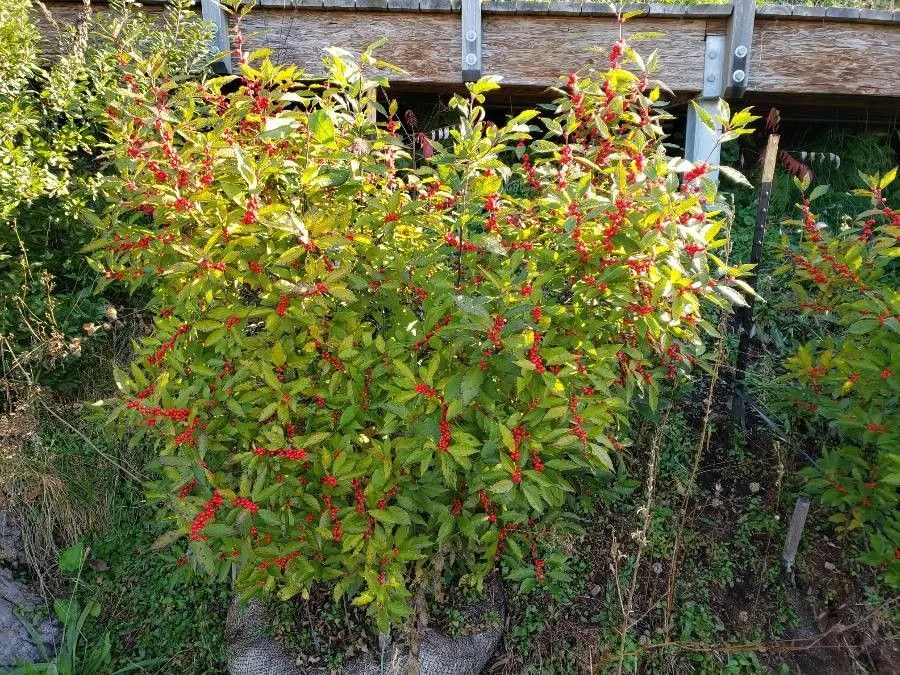
Author: (L.) A.Gray
Bibliography: Manual: 307 (1848)
Year: 1848
Status: accepted
Rank: species
Genus: Ilex
Vegetable: False
Observations: E. Canada to C. & E. U.S.A.
Black-alder, also known by its scientific name Ilex verticillata, is a deciduous shrub renowned for its striking appearance and ecological importance. Belonging to the family Aquifoliaceae, this plant is native to the regions extending from Eastern Canada down to the Central and Eastern United States.
One of the most distinctive features of Black-alder is its bright red berries, which appear in late summer and persist through the winter months, providing a vibrant contrast against the often stark winter landscape. These berries are not only visually appealing but also serve as a crucial food source for various bird species during the colder months when food is scarce.
The Black-alder typically thrives in moist environments, often found along the edges of wetlands, in swamps, and near creeks and ponds. Its adaptability to wet soils makes it an excellent choice for landscaping in areas prone to flooding or poor drainage, where many other plants may struggle to survive.
In addition to its ornamental and ecological benefits, Ilex verticillata is appreciated for its moderate size, usually growing to heights of 6 to 10 feet. Its foliage, which turns a charming yellow in the fall, adds to its seasonal interest. The leaves are simple, alternating, and have a distinct serrated margin, easily identifiable to those familiar with the plant.
Historically, the presence of Black-alder in North American landscaping and natural settings has been documented as far back as 1848, as referenced in the botanical manual of that time. This historical context emphasizes the plant’s long-standing integration into the continent’s flora, as well as its continued relevance in modern-day horticulture and conservation efforts.
In summary, Ilex verticillata (Black-alder) is not only an attractive addition to any garden or natural habitat but also a significant part of the local ecosystem, offering beauty and sustenance through the seasons. Its history, adaptability, and ecological contributions make it a valuable plant species from Eastern Canada to the Central and Eastern United States.
Eng: black-alder, common winterberry, virginia winterberry, winterberry, winterberry holly, black holly
Deu: amerikanische winterbeere
Fra: houx, houx verticillé
Swe: sommarjärnek
En: Black-alder, Virginia winterberry, Winterberry, Common winterberry, Michigan holly, Winterberry Holly, Black alder, Coralberry, Black holly
Zh: 加拿大冬青
Cs: Cesmína přeslenitá
Da: Virginsk Vinterbær
Fi: Kesäorjanlaakeri
Fr: Houx, Houx verticillé
De: Amerikanische Winterbeere, Rote Winterbeere, Sommergrüne Stechpalme
Fa: توسکای فلسدار
Sk: Cezmína praslenovitá
Sv: Sommarjärnek
Taken Nov 18, 2021 by guinnevere lowe (cc-by-sa)
Taken Oct 11, 2013 by EOL − Jesse Lincoln (cc-by-nc)
Taken Sep 17, 2020 by jon safer (cc-by-sa)
Taken Nov 9, 2021 by William Coville (cc-by-sa)
Taken Oct 3, 2021 by Secret Girl (cc-by-sa)
Taken Jun 29, 2019 by Wilhelm Rogmann (cc-by-sa)
Taken Jun 29, 2019 by Wilhelm Rogmann (cc-by-sa)
Taken Jun 5, 2022 by William Coville (cc-by-sa)
Taken Jul 29, 2021 by Steve Orridge (cc-by-sa)
Taken Sep 10, 2018 by Cornel Buzea (cc-by-sa)
Taken Nov 11, 2022 by Nicolas Tison (cc-by-sa)
Taken Dec 21, 2020 by Jean Bonnefoy (cc-by-sa)
Taken Nov 21, 2021 by monika (cc-by-sa)
Taken Nov 30, 2020 by Freddy Freddy (cc-by-sa)
Taken Dec 13, 2020 by Jamie Fleck (cc-by-sa)
Taken Nov 26, 2021 by Sonlight (cc-by-sa)
Taken Sep 30, 2022 by manuseitz (cc-by-sa)
Taken May 30, 2020 by Jitendra Kumar Sahoo (cc-by-sa)
Taken Oct 11, 2020 by catherine white (cc-by-sa)
Taken Nov 9, 2021 by William Coville (cc-by-sa)
Taken May 31, 2007 by EOL − Steven J. Baskauf (cc-by-nc-sa)
Taken May 31, 2007 by EOL − Steven J. Baskauf (cc-by-nc-sa)
Taken Jan 2, 2004 by EOL − Steven J. Baskauf (cc-by-nc-sa)
Taken Nov 26, 2021 by Sonlight (cc-by-sa)
Taken Jan 25, 2021 by max (cc-by-sa)
Taken Sep 23, 2021 by Brett Bockhop (cc-by-sa)
Taken Oct 9, 2022 by Taylor (cc-by-sa)
Taken Dec 4, 2020 by Karla Borecky (cc-by-sa)
Taken Jul 3, 2021 by Sofia Eichelmann (cc-by-sa)
Taken Dec 9, 2021 by Lisa (cc-by-sa)
Growth form: Multiple Stem
Growth habit: Tree, Shrub
Growth rate: Moderate
Ph maximum: 7.5
Ph minimum: 4.5
Family: Myrtaceae Author: (F.Muell.) K.D.Hill & L.A.S.Johnson Bibliography: Telopea 6: 402 (1995) Year: 1995 Status:…
Family: Rubiaceae Author: Pierre ex A.Froehner Bibliography: Notizbl. Bot. Gart. Berlin-Dahlem 1: 237 (1897) Year:…
Family: Sapindaceae Author: Koidz. Bibliography: J. Coll. Sci. Imp. Univ. Tokyo 32(1): 38 (1911) Year:…
Family: Asteraceae Author: A.Gray Bibliography: Pacif. Railr. Rep.: 107 (1857) Year: 1857 Status: accepted Rank:…
Family: Fabaceae Author: Medik. Bibliography: Vorles. Churpfälz. Phys.-Ökon. Ges. 2: 398 (1787) Year: 1787 Status:…
Family: Aspleniaceae Author: (Cav.) Alston Bibliography: Bull. Misc. Inform. Kew 1932: 309 (1932) Year: 1932…